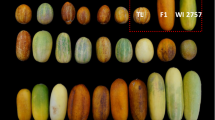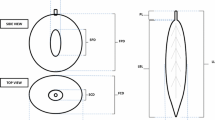Abstract
An 80-point genetic map [77 random-amplified polymorphic DNAs (RAPD), F (female sex expression), de (determinate), and ll (little leaf)] was constructed from a narrow cross in cucumber using the determinate, gynoecious, standard-sized leaf line G421 and the indeterminate, monoecious, little leaf line H-19. The map defined nine linkage groups and spanned ca. 600 cM with an average distance between markers of 8.4 ± 9.4 cM. The RAPD loci BC-551 and BC-592 were found to flank ll at 3.4 and 12.2 cM, respectively. The locus OP-L18-2 was linked (16 cM) to de, and the F locus was flanked by markers at 44 and 31 cM. One-hundred F3 families were used to identify quantitative trait loci (QTL) for sex expression, main stem length, number of lateral branches, days to anthesis, fruit number and weight, fruit length and diameter, and fruit length: diameter ratio in two replicated test locations (Wisconsin and Georgia). QTL on linkage group B explained major portions (R2 = ca. 2 to 74%) of the variation observed for sex expression, main stem length, lateral branch number, and fruit diameter (LOD = 2.1 to 29.8). Although ca. 62 to 74% of the variation for sex expression was associated with a putative QTL spanning the F locus (OP-AJ-2 to F and F to de), other regions (three) of the genome were important for the determination of sex in the F3 families examined depending upon environment. The number of genomic regions affecting main stem length (five) and number of lateral branches (three) coincided with expectations as determined by calculations of minimum number of genes in previous studies. Evaluation of QTL associated with several fruit number determinants of early, first-harvest yield demonstrating additive genetic variance (i.e., sex expression, main stem length, and number of laterals) suggests that marker-assisted selection may have utility for the development of determinate, multiple lateral branching germplasm suited for once-over mechanical harvesting in this population.
Similar content being viewed by others
References
Allard RW: Principles of Plant Breeding. John Wiley, New York/London (1960).
Beckmann JS, Soller M: Restriction fragment length polymorphisms in genetic improvement: methodologies, mapping, and costs. Theor Appl Genet 67: 35–43 (1983).
Bonierbale MW, Plaisted RL, Pineda O, Tanksley SD: QTL analysis of trichome-mediated insect resistance in potato. Theor Appl Genet 87: 973–987 (1994).
Cantliffe DJ: Alteration of sex expression in cucumber due to changes in temperature, light intensity, and photoperiod. J Am Soc Hort Sci 106: 133–136 (1981).
Dijkhuizen A: Application of restriction fragment length polymorphism for the assessment of genetic variability and study of quantitatively inherited traits in cucumber (Cucumis sativus L.). Ph.D. thesis, University of Wisconsin-Madison (1994).
Dijkuizen A, Kennnard WC, Havey MJ, Staub JE: RFLP variability and genetic relationships in cultivated cucumber. Euphytica 90: 79–87 (1996).
Edwards MD, Stuber CW, Wendel JF: Molecular-marker-facilitated investigations of quantitative-trait loci in maize. I. Numbers, genomic distribution, and types of gene action. Genetics 116: 113–125 (1987).
Falconer DS: Introduction to quantitative genetics. Longman Scientific and Technical, UK (1989).
Galun E: Study of the inheritance of sex expression in the cucumber. The interaction ofmajor genewithmodifying genetic and non-genetic factors. Genetica 13: 1–8 (1971).
Gimelfarb A, Lande R: Marker-assisted selection and marker-QTL associations in hybrid populations. Theor Appl Genet 91: 522–528 (1995).
Goode MJ, Bowers JL, Morelock TE: Arkansas little leaf cucumber. American Society of Horticultural Science, Annual Meeting/programs and abstracts (1989).
Hauge BM, Hanley SM, Cartinhour S, Cherry JM, Goodman HM, Koornneef M, Stam P, Chang C, Kempin S, Medrano L, Meyerowitz EM: An integrated genetic/RFLP map of the Arabidopsis thaliana genome. Plant J 3: 745–754 (1993).
Kelly J: Use of random amplified polymorphic DNA markers in breeding for major resistance to plant pathogens. HortScience 30: 461–465 (1995).
Kennard WC, Poetter K, Dijkhuizen A, Meglic V, Staub JE, Havey MJ: Linkages among RFLP, RAPD, isozyme, disease resistance, and morphological markers in narrow and wide crosses of cucumber. Theor Appl Genet 89: 42–48 (1994).
Kennard WC, Havey MJ: Quantitative trait analysis of fruit quality in cucumber; QTL detection, confirmation, and comparison with mating-design variation. Theor Appl Genet 91: 53–61 (1995).
Knerr LD, Staub JE, Holder DJ, May BP: Genetic diversity in Cucumis sativus L. assessed by variation at 18 allozyme coding loci. Theor Appl Genet 78: 119–128 (1989).
Kosambi DD: The estimation of map distance from recombination values. Ann Eugen 19: 172–175 (1994).
Knapp SJ: Mapping quantitative trait loci. In: Phillips RL and Vasil IK (eds) DNA-Based Markers in Plants, pp. 5896. Kluwer Academic Publishers, Dordrecht, Netherlands (1994).
Kubicki B: Investigations on sex determination in cucumber (Cucumis sativus L.). Genet Pol 10: 3–143 (1969).
Kupper R, Staub JE: Combining ability between lines of Cucumis sativus L. and Cucumis sativus var. hardwickii (R.) Alef. Euphytica 38: 197–210 (1988).
Lander ES, Green P, Abrahamson J, Barlow A, Daly MJ, Lincoln SE, Newberg L: MAPMAKER: an interactive computer package for constructing primary genetic linkage maps of experimental and natural populations. Genomics 1: 174–181 (1987).
Lander ES, Botstein D: Mapping mendelian factors underlying quantitative traits using RFLP linkage maps. Genetics 121: 185–199 (1989).
Lincoln SE, Lander ES: Systematic detection of errors in genetic linkage data. Genomics 1: 174–181 (1992).
Lower RL, Nienhuis J, Miller CH: Gene action and heterosis for yield and vegetative characteristics in a cross between a gynoecious pickling cucumber inbred and a Cucumis sativus var. hardwickii line. J Am Soc Hort Sci 107: 75–82 (1982).
Michelmore RW, Paran I, Kesseli RV: Identification of markers linked to disease resistance genes by bulked segregant analysis: a rapid method to detect markers in specific genomic regions using segregating populations. Proc Natl Acad Sci USA 88: 9828–9832 (1991).
Nodari RO, Tsai SM, Guzman P, Gilbertson RL, Gepts P: Toward an integrated linkage map of common bean. III. Mapping genetic factors controlling host-bacteria interactions. Genetics 134: 341–350 (1993).
Paterson AH, Deverna JW, Lanini B, Tanksley SD: Fine mapping of quantitative trait loci using a selected overlapping recombinant chromosome in an interspecies cross of tomato. Genetics 124: 735–724 (1990).
Pierce LK, Wehner TC: Review of genes and linkage groups in cucumber. HortScience 25: 605–615 (1990).
SAS: SAS/STAT Users guide, release version 6.03. SAS Institute, Cary, NC (1988).
Serquen FC, Staub JE: Environment can effect the placement of discrete traits on genetic maps: the case of sex expression in cucumber. Cucurbit Genet Coop Rpt 9: 10–12 (1996).
Serquen FC, Staub JE: Underestimation of detection of QTL when using dominant genetic markers: the case of RAPDs in cucumber. Cucurbit Genet Coop Rpt 19: 13–16 (1996).
Serquen FC, Bacher J, Staub JE: Genetic analysis of yield components in cucumber (Cucumis sativus L.) at low plant density. J Am Soc Hort Sci, in press (1997).
Shifriss O: Sex control in cucumbers. J Hered 52: 5–12 (1961).
Smith OS, Lower RL, Moll RH: Estimates of heritabilities and variance components in pickling cucumber. J Am Soc Hort Sci 103: 222–225 (1978).
Stam P: Construction of integrated genetic linkage maps by means of a new computer package: JoinMap. Plant J 3: 739–744 (1993).
Staub JE, Knerr LD, Hopen HJ: Effects of plant density and herbicides on cucumber productivity. J Am Soc Hort Sci 117: 48–53 (1992).
Staub JE, Peterson CE, Crubaugh LK, Palmer MJ: Cucumber population WI 6383 and derived inbreds WI 5098 and WI 5551. HortScience 27: 1340–1341 (1993).
Staub JE, Crubaugh L: Selection for multiple lateral determinate cucumber genotypes. Cucurbit Genet Coop Rpt 18: 5–6 (1995).
Staub JE, Bacher J, Crubaugh L: Problems associated with the selection of determinate cucumber (Cucumis sativus L.) plant types in a multiple lateral background. Cucurbit Genet Coop Rpt 18: 7–9 (1995).
Staub JE, Bacher J: Cucumber as a processed vegetable. In: Processing vegetables: science and technology. Technomic Publishing Company, Lancaster, PA (in press).
Staub JE, Serquen FC, Gupta M: Genetic markers, map construction, and their application in plant breeding. HortScience 31: 729–741 (1996).
Staub JE, Bacher J, Poetter K: Sources of potential errors in the application of random amplified polymorphic DNAs in cucumber. HortScience 31: 262–266 (1996).
Strefler MS, Wehner TC: Estimates of heritabilities and genetic variances of three yield and five quality traits in three fresh market cucumber populations. J Am Soc Hort Sci 111: 599–605 (1986).
Tanksley SD, Medina-Filho H, Rick CM: Use of naturally occurring enzyme variation to detect andmap genes controlling quantitative traits in an interspecific backcross of tomato. Heredity 49: 11–25 (1982).
Tansksley S: Molecular markers in plant breeding. Plant Mol Biol Rep 1: 3–8 (1983).
Trebitsh T, Staub JE, O'Neil SD: Identification of an 1-aminocyclopropane-1-carboxylate synthase gene linked to the female gene (F) that determines female sex expression in cucumber (Cucumis sativus L.) Plant Physiol, in press (1997).
Young ND, Zamir D, Ganal MW, Tanksley SD: Use of isogenic lines and simultaneous probing to identify DNA markers tightly linked to the Tm-2a gene in tomato. Genetics 120: 579–585 (1988).
Zhang Q, Gabert AC, Baggett JR: Parents and mating systems affect the transfer of gynoecious flowering to Chinese monoecious cucumbers. J Am Soc Hort Sci 117: 515–517 (1992).
Author information
Authors and Affiliations
Rights and permissions
About this article
Cite this article
Serquen, F.C., Bacher, J. & Staub, J. Mapping and QTL analysis of horticultural traits in a narrow cross in cucumber (Cucumis sativus L.) using random-amplified polymorphic DNA markers. Molecular Breeding 3, 257–268 (1997). https://doi.org/10.1023/A:1009689002015
Issue Date:
DOI: https://doi.org/10.1023/A:1009689002015




